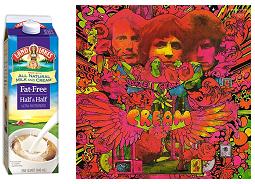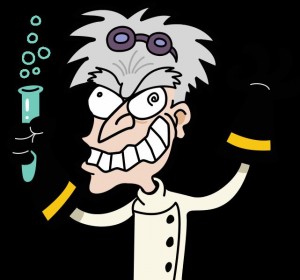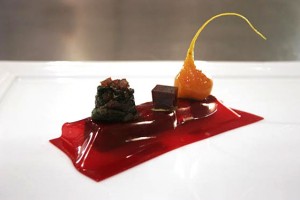Processed non-junk food
or
as close to “non-junk” as processed food can be
Notice the inverse relationship between fat content and the number of ingredients in these three commercially available sour cream products. This is processed food.
Regular:
Cultured pasteurized grade A cream and milk, enzymes.
Low-Fat:
Cultured Milk, Cream, Nonfat Dry Milk, Whey, Modified Corn Starch, Sodium Phosphate, Guar Gum, Carrageenan, Calcium Sulfate, Locust Bean Gum, Gelatin, Vitamin A Palmitate.
Fat Free:
Cultured Low-fat Milk, Modified Corn Starch, Whey Protein Concentrate, Propylene Glycol Monoester, Artificial Color, Gelatin, Sodium Phosphate, Agar Gum, Xanthan Gum, Sodium Citrate, Locust Bean Gum, Vitamin A Palmitate.
“Fat-Free Half & Half”

not cream
In general, “Half & Half” refers to a 50:50 blend of whole milk and cream. People think it’s better than cream because it has less fat. Whole milk is about 3% fat by weight, while cream is about 30%. Mix ‘em together and you end up with Half & Half, which is somewhere in between (12-14%). Fat has a profound effect on flavor and texture… so how exactly does “Fat-Free Half & Half” taste and feel just like regular Half & Half?!? Muah ha ha ha haaaa!

divide and conquer
From what I can gather, the fat is replaced with corn syrup and pharmaceutical grade thickeners, emulsifiers, etc., scientifically engineered to mimic the precise flavor and texture of Half & Half. There are even artificial colors added to make it look like cream. There are artificial colors added to make it look like cream? AYFKM? For some reason, I find this oddly offensive. It is to these artificial colors which I object. I want this concoction (that is advertised as better than cream) to look like whatever “corn syrup, carrageenan, sodium citrate, dipotassium phosphate, mono and diglycerides, and vitamin A palmitate” looks like. And it should release a pale green mist upon contact with coffee.
The sugar in Fat-Free Half & Half comes from corn syrup, while that in real dairy is lactose. Glucose is sweeter than lactose, and there’s 2-3x more sugar in Fat-Free Half & Half. Does this mean people use less of it? I doubt it, because the additional sweetness is probably necessary to compensate for the lack of fat.
And what about all the other additives in Fat-Free Half & Half? This is reminiscent of the introduction of trans fats into our diet by way of replacing butter and lard with margarine and shortening…
Carrageenan is partially responsible for improving the mouthfeel and texture of Fat-Free Half & Half.

carrageenan. Looks scary, right?
At high doses, it’s an inflammatory gut irritant. Given coffee’s not-so-gut-friendly reputation, do you really want to push it with carrageenan?
On another note, carrageenan is used to design some of the most beautifully artistic desserts.

In this context, I’m reminded of the phrase: “the dose makes the poison.” In other words, those dishes are a dietary rarity, reserved for the most special of occasions. At that level of exposure, it could be a blend of carrageenan, trans fat, sucrose, and Red #40, you could eat 5 of them at a time, and you’d never experience any malevolent effects. But what about a few tablespoons in your coffee every morning for 30 years??? (alternatively, perhaps I’m underestimating carrageenan exposure a bit) (other, more sordid uses of carrageenan )
)
Avoid processed foods, especially when they’re no more convenient or healthy their conventional counterparts.
calories proper
P.S. Perhaps I was a little too hard on Fat-Free Half & Half. It’s not as bad as microwave popcorn, or this classic:
One 43 gram Twinkie contains 5 grams of fat, 25 grams of sugars, 1 gram of protein, no fibre, 150 kcal, and over 35 ingredients:
contains 5 grams of fat, 25 grams of sugars, 1 gram of protein, no fibre, 150 kcal, and over 35 ingredients:
- Enriched Wheat Flour – enriched with ferrous sulphate, B vitamins (niacin, thiamine mononitrate, ribofavin and folic acid).
- Sugar
- Corn syrup
- Water
- High fructose corn syrup
- Vegetable shortening – containing one or more of partially hydrogenated soybean, cottonseed or canola oil, and beef fat. [trans fat]
- Dextrose
- Whole eggs
- Modified corn starch
- Cellulose gum
- Whey
- Leavenings (sodium acid pyrophosphate, baking soda, monocalcium phosphate)
- Salt
- Cornstarch
- Corn flour
- Corn syrup solids
- Mono and diglycerides
- Soy lecithin
- Polysorbate 60
- Dextrin
- Calcium caseinate
- Sodium stearol lactylate
- Wheat gluten
- Calcium sulphate
- Natural and artificial flavours
- Caramel colour
- Sorbic acid (to retain freshness)
- Colour added (yellow 5, red 40)







